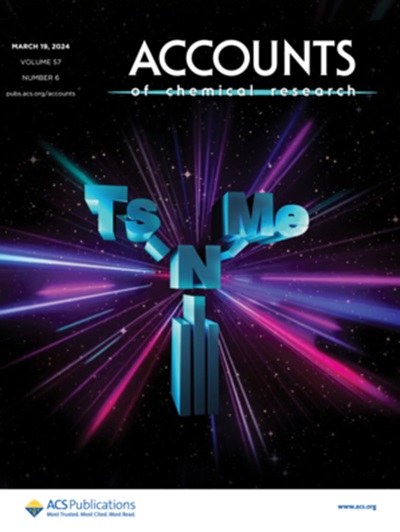Construction and Function of Low-Symmetry Metallo-Supramolecules.
IF 16.4
1区 化学
Q1 CHEMISTRY, MULTIDISCIPLINARY
引用次数: 0
Abstract
ConspectusNatural systems often exhibit high-symmetry structures, which are vital in biological processes. Inspired by nature, chemists have focused on designing high-symmetry metallo-supramolecular architectures due to the high predictability and controllability for self-assembly. In contrast, low-symmetry structures are ubiquitous and also play a key role in living systems. Mimicking natural low-symmetry structures has proven challenging; substantial efforts have been devoted to developing low-symmetry metallo-supramolecules. However, there are still significant challenges in both construction and function of low-symmetry metallo-supramolecules: (1) unexpected structures with similar thermodynamic stability will be generated, resulting in uncontrollable self-assembly; (2) functionalized low-symmetry supramolecular systems are limited by uncontrollable self-assembly. To address the key challenges, we developed various strategies to control the assembly process and explore the functionalities. In this Account, we summarize the recent research progress achieved by our efforts in preparing low-symmetry metallo-supramolecules and exploring their functionalities. First, the efficient approaches are discussed: (1) precise configurational control by subtly modulating ligands, (2) ligand and metal-ion selectivities enabled by selective self-complementary coordination motifs, and (3) enhancing the steric effect to control coordination modes. Second, the functionality of multidecker structures with well-organized homo/hetero-chromophoric arrangements will be introduced. Finally, a low-symmetry functionalized prismatic system with high universality was developed, which realized a high photoluminescence quantum yield, tunable luminescence, mechanically interlocked structures, and selective encapsulation of low-symmetry guests.低对称金属超分子的结构与功能。
自然系统通常表现出高度对称的结构,这在生物过程中是至关重要的。受大自然的启发,化学家们一直致力于设计高度对称的金属超分子结构,因为自组装具有高度的可预测性和可控制性。相反,低对称结构无处不在,在生命系统中也起着关键作用。事实证明,模仿自然的低对称结构具有挑战性;低对称性金属超分子的研究已经取得了长足的进展。然而,低对称性金属超分子在结构和功能方面仍面临重大挑战:(1)会产生具有相似热力学稳定性的意外结构,导致不可控的自组装;(2)功能化低对称超分子系统受不可控自组装的限制。为了解决关键挑战,我们开发了各种策略来控制装配过程并探索功能。本文综述了近年来低对称金属超分子的制备及其功能的研究进展。首先,讨论了有效的方法:(1)通过巧妙调节配体来精确控制构型;(2)通过选择性自互补配位基序实现配体和金属离子的选择性;(3)增强空间效应来控制配位模式。其次,将介绍具有良好组织的同/异色排列的多层结构的功能。最后,开发了具有高通用性的低对称功能化棱镜体系,实现了高光致发光量子产率、可调谐发光、机械互锁结构和低对称客体的选择性封装。
本文章由计算机程序翻译,如有差异,请以英文原文为准。
求助全文
约1分钟内获得全文
求助全文
来源期刊

Accounts of Chemical Research
化学-化学综合
CiteScore
31.40
自引率
1.10%
发文量
312
审稿时长
2 months
期刊介绍:
Accounts of Chemical Research presents short, concise and critical articles offering easy-to-read overviews of basic research and applications in all areas of chemistry and biochemistry. These short reviews focus on research from the author’s own laboratory and are designed to teach the reader about a research project. In addition, Accounts of Chemical Research publishes commentaries that give an informed opinion on a current research problem. Special Issues online are devoted to a single topic of unusual activity and significance.
Accounts of Chemical Research replaces the traditional article abstract with an article "Conspectus." These entries synopsize the research affording the reader a closer look at the content and significance of an article. Through this provision of a more detailed description of the article contents, the Conspectus enhances the article's discoverability by search engines and the exposure for the research.
 求助内容:
求助内容: 应助结果提醒方式:
应助结果提醒方式:


